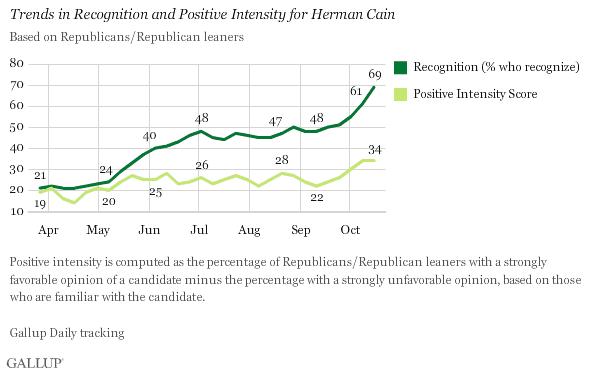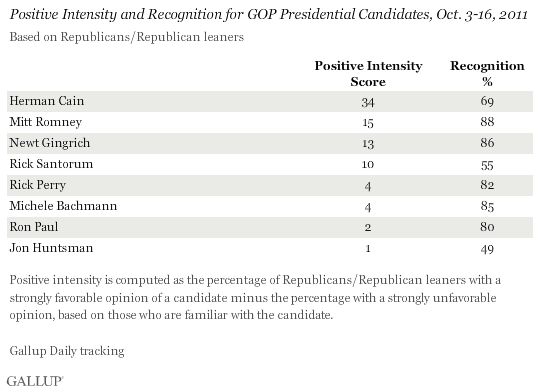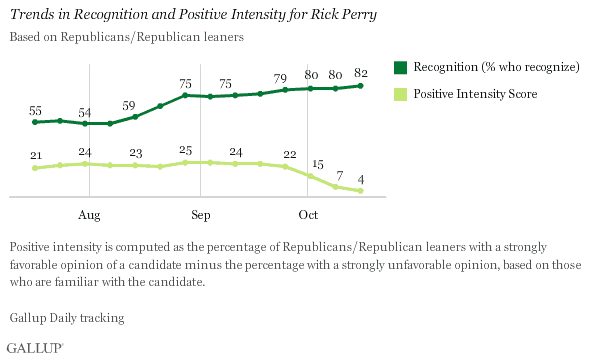PRINCETON, NJ -- Republicans' intensely positive views of Herman Cain remained high over the past week, even as the percentage of Republicans familiar with him rose from 61% to 69%.

Cain's 34 Positive Intensity Score in Gallup Daily tracking conducted Oct. 3-16 is identical to results from Gallup's prior two-week rolling average, conducted Sept. 26-Oct. 9. His score is also more than twice as high as the next-most-favorably reviewed Republican, Mitt Romney, who is at 15. Newt Gingrich earns 13, followed by Rick Santorum with 10.

Of the eight Republican presidential hopefuls Gallup now tracks, Michele Bachmann, Rick Perry, Ron Paul, and Jon Huntsman have the lowest Positive Intensity Scores, all in the low single digits. The reversal for Perry is particularly striking: a month ago, he tied Cain for the lead on this dimension with 24.

Bottom Line
Since mid-September, Cain has seen substantial increases in three key areas of his image and support among Republicans nationwide. Recognition of him has risen from 50% to 69%; his Positive Intensity Score has gone from 24 (among the highest in the GOP field) to 34 (the highest); and his share of the Republican vote for the nomination has risen from 5% to 18%.
Cain now leads all other Republicans by a significant margin in positive intensity, is nearly tied with Romney for the lead in the vote, and has room to grow in recognition. The obvious risk is that any major stumbles in the upcoming debates could send Cain's vital signs in the other direction, mirroring the declines in support seen to date for Perry and, previously, for Bachmann and Gingrich. Gingrich has recently recovered slightly in positive intensity from the very low readings he had during the summer, but he has yet to return to double digits in Republican vote preferences. Through it all, Romney's positive intensity and support for the nomination have been remarkably stable, albeit modest.
Survey Methods
Results are based on telephone interviews conducted as part of Gallup Daily tracking Oct. 3-16, 2011, with random samples of Republicans and Republican-leaning independents, aged 18 and older, living in all 50 U.S. states and the District of Columbia. Questions asking about the eight candidates measured in this research were rotated among randomly selected samples of Republicans each night; over the 14-day period, each candidate was rated by approximately 1,500 Republicans and Republican-leaning independents.
For the overall ratings of each potential candidate among Republicans and Republican-leaning independents, including recognition scores, one can say with 95% confidence that the maximum margin of sampling error is ±3 percentage points. For the Positive Intensity Score for each candidate, the maximum margin of sampling error varies depending on the size of the group recognizing the candidate.
Interviews are conducted with respondents on landline telephones and cellular phones, with interviews conducted in Spanish for respondents who are primarily Spanish-speaking. Each sample includes a minimum quota of 400 cell phone respondents and 600 landline respondents per 1,000 national adults, with additional minimum quotas among landline respondents by region. Landline telephone numbers are chosen at random among listed telephone numbers. Cell phone numbers are selected using random-digit-dial methods. Landline respondents are chosen at random within each household on the basis of which member had the most recent birthday.
Samples are weighted by gender, age, race, Hispanic ethnicity, education, region, adults in the household, and phone status (cell phone only/landline only/both, cell phone mostly, and having an unlisted landline number). Demographic weighting targets are based on the March 2010 Current Population Survey figures for the aged 18 and older non-institutionalized population living in U.S. telephone households. All reported margins of sampling error include the computed design effects for weighting and sample design.
In addition to sampling error, question wording and practical difficulties in conducting surveys can introduce error or bias into the findings of public opinion polls.
For more details on Gallup's polling methodology, visit www.gallup.com.
